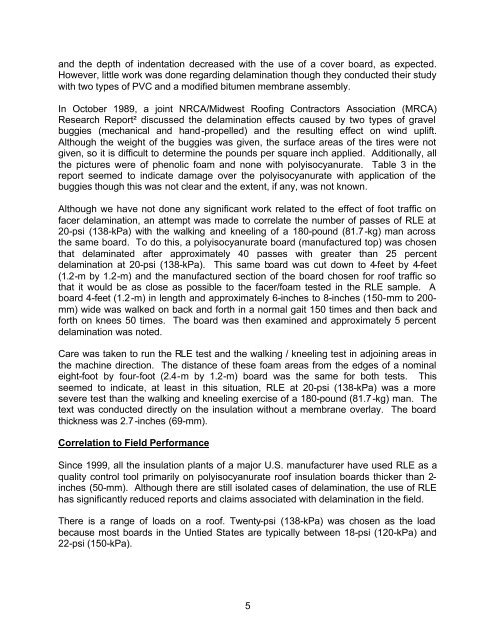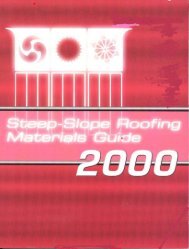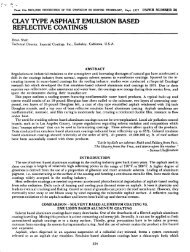1 Study of Polyisocyanurate Rigid Foam Board Facer Behavior ...
1 Study of Polyisocyanurate Rigid Foam Board Facer Behavior ...
1 Study of Polyisocyanurate Rigid Foam Board Facer Behavior ...
Create successful ePaper yourself
Turn your PDF publications into a flip-book with our unique Google optimized e-Paper software.
and the depth <strong>of</strong> indentation decreased with the use <strong>of</strong> a cover board, as expected.<br />
However, little work was done regarding delamination though they conducted their study<br />
with two types <strong>of</strong> PVC and a modified bitumen membrane assembly.<br />
In October 1989, a joint NRCA/Midwest Ro<strong>of</strong>ing Contractors Association (MRCA)<br />
Research Report² discussed the delamination effects caused by two types <strong>of</strong> gravel<br />
buggies (mechanical and hand-propelled) and the resulting effect on wind uplift.<br />
Although the weight <strong>of</strong> the buggies was given, the surface areas <strong>of</strong> the tires were not<br />
given, so it is difficult to determine the pounds per square inch applied. Additionally, all<br />
the pictures were <strong>of</strong> phenolic foam and none with polyisocyanurate. Table 3 in the<br />
report seemed to indicate damage over the polyisocyanurate with application <strong>of</strong> the<br />
buggies though this was not clear and the extent, if any, was not known.<br />
Although we have not done any significant work related to the effect <strong>of</strong> foot traffic on<br />
facer delamination, an attempt was made to correlate the number <strong>of</strong> passes <strong>of</strong> RLE at<br />
20-psi (138-kPa) with the walking and kneeling <strong>of</strong> a 180-pound (81.7-kg) man across<br />
the same board. To do this, a polyisocyanurate board (manufactured top) was chosen<br />
that delaminated after approximately 40 passes with greater than 25 percent<br />
delamination at 20-psi (138-kPa). This same board was cut down to 4-feet by 4-feet<br />
(1.2-m by 1.2-m) and the manufactured section <strong>of</strong> the board chosen for ro<strong>of</strong> traffic so<br />
that it would be as close as possible to the facer/foam tested in the RLE sample. A<br />
board 4-feet (1.2-m) in length and approximately 6-inches to 8-inches (150-mm to 200mm)<br />
wide was walked on back and forth in a normal gait 150 times and then back and<br />
forth on knees 50 times. The board was then examined and approximately 5 percent<br />
delamination was noted.<br />
Care was taken to run the RLE test and the walking / kneeling test in adjoining areas in<br />
the machine direction. The distance <strong>of</strong> these foam areas from the edges <strong>of</strong> a nominal<br />
eight-foot by four-foot (2.4-m by 1.2-m) board was the same for both tests. This<br />
seemed to indicate, at least in this situation, RLE at 20-psi (138-kPa) was a more<br />
severe test than the walking and kneeling exercise <strong>of</strong> a 180-pound (81.7-kg) man. The<br />
text was conducted directly on the insulation without a membrane overlay. The board<br />
thickness was 2.7-inches (69-mm).<br />
Correlation to Field Performance<br />
Since 1999, all the insulation plants <strong>of</strong> a major U.S. manufacturer have used RLE as a<br />
quality control tool primarily on polyisocyanurate ro<strong>of</strong> insulation boards thicker than 2-<br />
inches (50-mm). Although there are still isolated cases <strong>of</strong> delamination, the use <strong>of</strong> RLE<br />
has significantly reduced reports and claims associated with delamination in the field.<br />
There is a range <strong>of</strong> loads on a ro<strong>of</strong>. Twenty-psi (138-kPa) was chosen as the load<br />
because most boards in the Untied States are typically between 18-psi (120-kPa) and<br />
22-psi (150-kPa).<br />
5





